 The
house is currently in the design and fund raising stage.
We are working with TLC Engineering on the design of the
house to achieve the Platinum level of accreditation. This
level of accreditation is only held by 15 other buildings
in the world. None of these buildings are under the most
current version of the requirements. FSU and ESC would
like to be the first to achieve this achievement in
Florida, setting the standard for FSU and bringing
exposure to our area in the fields of engineering and
environmentally friendly development. Not only are we
showing a consciousness in this field but we are striving
to be the best. We are in a hold due to funding at the
moment but ESC along with FSU Foundation and key
influential people in our community are working to rectify
this problem. Stay tuned for further updates.
The
house is currently in the design and fund raising stage.
We are working with TLC Engineering on the design of the
house to achieve the Platinum level of accreditation. This
level of accreditation is only held by 15 other buildings
in the world. None of these buildings are under the most
current version of the requirements. FSU and ESC would
like to be the first to achieve this achievement in
Florida, setting the standard for FSU and bringing
exposure to our area in the fields of engineering and
environmentally friendly development. Not only are we
showing a consciousness in this field but we are striving
to be the best. We are in a hold due to funding at the
moment but ESC along with FSU Foundation and key
influential people in our community are working to rectify
this problem. Stay tuned for further updates.
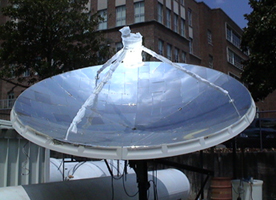 The solar-thermal tri-generation system is
designed to address the high-energy costs associated with
power production, refrigeration, and heating in lesser
developed areas or emergency situations. Our system at ESC
is currently in the testing process for power generation,
refrigeration, and water heating; it consists of a
concentrating solar concentrator and a thermal receiver.
The solar concentrator is of the parabolic dish type,
which is covered with a reflective aluminized mylar. This
focuses the sun’s rays onto the receiver mounted at the
focal point of the concentrator. The extreme temperatures
created at the focal region, in excess of 650C, is then
transferred by the receiver to heat a circulating fluid,
which is then transported elsewhere for various thermal
uses. For power production, the working fluid is water,
which is flashed to steam. This high-temperature,
high-pressure steam is then expanded through a small
high-speed turbine coupled with a generator for electric
power production. The exhaust steam is then condensed
before reentering the system so as to minimize working
fluid losses and increase system efficiency by preheating
the working fluid. For refrigeration and water heating, an
ethylene-glycol mixture is used. The ethylene-glycol
mixture is used as a thermal transport medium to transfer
the heat from the receiver to a thermal reservoir. For
refrigeration, the thermal reservoir is used in
conjunction with an anhydrous-ammonia refrigeration cycle.
This cycle is similar to the conventional refrigeration
cycle, however, instead of the refrigerant being
compressed by the work of a shaft from an electric
compressor, it is pressure driven by the addition of heat,
thus making off-grid refrigeration plausible. For water
heating, a heat exchanger is used in the thermal storage
reservoir. Instead of water being heated by an electric
heating element, the heat will be transferred from the
thermal reservoir to the water. Ideally, all three
components for the system will be able to operate
simultaneously for tri-generation in areas where off-grid
availability is essential.
The solar-thermal tri-generation system is
designed to address the high-energy costs associated with
power production, refrigeration, and heating in lesser
developed areas or emergency situations. Our system at ESC
is currently in the testing process for power generation,
refrigeration, and water heating; it consists of a
concentrating solar concentrator and a thermal receiver.
The solar concentrator is of the parabolic dish type,
which is covered with a reflective aluminized mylar. This
focuses the sun’s rays onto the receiver mounted at the
focal point of the concentrator. The extreme temperatures
created at the focal region, in excess of 650C, is then
transferred by the receiver to heat a circulating fluid,
which is then transported elsewhere for various thermal
uses. For power production, the working fluid is water,
which is flashed to steam. This high-temperature,
high-pressure steam is then expanded through a small
high-speed turbine coupled with a generator for electric
power production. The exhaust steam is then condensed
before reentering the system so as to minimize working
fluid losses and increase system efficiency by preheating
the working fluid. For refrigeration and water heating, an
ethylene-glycol mixture is used. The ethylene-glycol
mixture is used as a thermal transport medium to transfer
the heat from the receiver to a thermal reservoir. For
refrigeration, the thermal reservoir is used in
conjunction with an anhydrous-ammonia refrigeration cycle.
This cycle is similar to the conventional refrigeration
cycle, however, instead of the refrigerant being
compressed by the work of a shaft from an electric
compressor, it is pressure driven by the addition of heat,
thus making off-grid refrigeration plausible. For water
heating, a heat exchanger is used in the thermal storage
reservoir. Instead of water being heated by an electric
heating element, the heat will be transferred from the
thermal reservoir to the water. Ideally, all three
components for the system will be able to operate
simultaneously for tri-generation in areas where off-grid
availability is essential.
Solar radiation can be divided into direct beam radiation, diffuse radiation and reflected radiation. Concentrated Solar Power (CSP) applications can only collect the direct beam radiation. CSP includes parabolic troughs; parabolic dishes or heliostats. A Pyrheliometer is used to measure the direct beam radiation from the sun. The efficiency of the solar power plant can then be determined knowing the incoming direct beam radiation from the sun.
Pyrheliometers on the market today are extremely expensive making accurate CSP site data collection cost prohibitive. An affordable pyrheliometer would increase the ability for proper site selection and optimal design of a CSP system for specific sites. ESC is designing and implementing an affordable pyrheliometer that will provide the important data, allowing engineers to make better decisions when designing CSP applications.
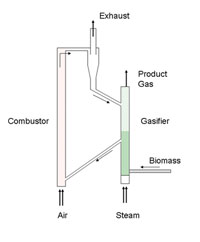 Biomass is a sustainable energy
source that has been used for thousands of years. New
technologies provide a way harness this energy source more
efficiently and cleaner than ever before. Biomass
gasification is the process of converting biomass, like
woodchips, sawdust, switch grass etc., to a usable gaseous
fuel. Conventional downdraft gasifiers produce a low
energy gas that is not suitable for storage or
transportation. By using a dual fluidized bed type
gasifier, a medium grade gas can be produced that is rich
in H2. As the figure shows, dual fluidized beds separate
the combustion products from the gasification products
leading to a much higher quality product gas. The product
can be used for power generation, conversion to liquid
fuel or H2 production. This type of gasification can
provide a sustainable path to producing H2 for new and
exciting technologies. Research being performed at ESC
will take this technology one step closer to mainstream
implementation.
Biomass is a sustainable energy
source that has been used for thousands of years. New
technologies provide a way harness this energy source more
efficiently and cleaner than ever before. Biomass
gasification is the process of converting biomass, like
woodchips, sawdust, switch grass etc., to a usable gaseous
fuel. Conventional downdraft gasifiers produce a low
energy gas that is not suitable for storage or
transportation. By using a dual fluidized bed type
gasifier, a medium grade gas can be produced that is rich
in H2. As the figure shows, dual fluidized beds separate
the combustion products from the gasification products
leading to a much higher quality product gas. The product
can be used for power generation, conversion to liquid
fuel or H2 production. This type of gasification can
provide a sustainable path to producing H2 for new and
exciting technologies. Research being performed at ESC
will take this technology one step closer to mainstream
implementation.
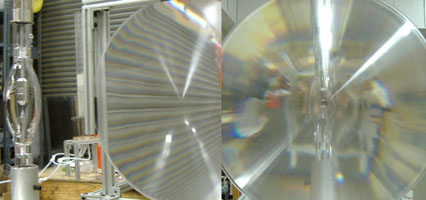 A solar simulator
allows us to test solar systems independent from current
weather conditions and time of day. This means that solar
research can happen at an accelerated rate because of the
amount of time able to study a system with constant
testing conditions. The simulator creates artificial
sunlight using xenon-arc lamps. These lamps produce
similar quality light to that of the sun. With the help of
a Fresnel lens, this light is made into direct beam
radiation with intensity of about 1 sun. By making direct
beams of light we are able to test systems that
concentrate sunlight as well as those that do not. The
lights are arranged in an array to produce a large area
for testing. This area is adjustable by adding or
subtracting lights and lens but is ultimately limited by
the size of the room.
A solar simulator
allows us to test solar systems independent from current
weather conditions and time of day. This means that solar
research can happen at an accelerated rate because of the
amount of time able to study a system with constant
testing conditions. The simulator creates artificial
sunlight using xenon-arc lamps. These lamps produce
similar quality light to that of the sun. With the help of
a Fresnel lens, this light is made into direct beam
radiation with intensity of about 1 sun. By making direct
beams of light we are able to test systems that
concentrate sunlight as well as those that do not. The
lights are arranged in an array to produce a large area
for testing. This area is adjustable by adding or
subtracting lights and lens but is ultimately limited by
the size of the room.
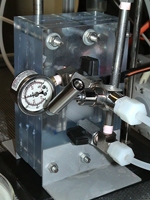 A
significant hurdle to the implementation of a
hydrogen-based economy is the fact that hydrogen cannot be
made at an economically feasible price. It is widely
speculated that water electrolysis, which separates water
into its component elements of hydrogen and oxygen, will
be the means of generating hydrogen in this type of
economy. Water electrolysis systems (electrolyzers)
currently employ either platinum or nickel-based alloy
electrodes, which can account for up to 80% of the cost of
a commercial electrolyzer. Based on an analysis of the
Photosystem II process, which is widely observed in
nature, thin metal oxide films have been developed in the
laboratory at FSU for the purpose of improving water
electrolysis. These films have demonstrated the ability to
generate both hydrogen and oxygen near their thermodynamic
limits, thus allowing for efficiencies above 99%.
A
significant hurdle to the implementation of a
hydrogen-based economy is the fact that hydrogen cannot be
made at an economically feasible price. It is widely
speculated that water electrolysis, which separates water
into its component elements of hydrogen and oxygen, will
be the means of generating hydrogen in this type of
economy. Water electrolysis systems (electrolyzers)
currently employ either platinum or nickel-based alloy
electrodes, which can account for up to 80% of the cost of
a commercial electrolyzer. Based on an analysis of the
Photosystem II process, which is widely observed in
nature, thin metal oxide films have been developed in the
laboratory at FSU for the purpose of improving water
electrolysis. These films have demonstrated the ability to
generate both hydrogen and oxygen near their thermodynamic
limits, thus allowing for efficiencies above 99%.
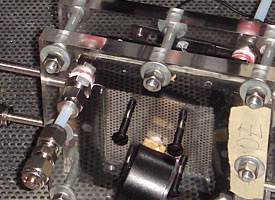 PEM fuel cells have the
benefits of quick start-up and relatively low temperature
operation, which make them the most likely candidates for
use in automobile and home applications. In order for
these fuel cells to achieve widespread adoption a number
of engineering challenges must be overcome. Two of these
challenges, the even distribution of hydrogen and air
across the membrane and the need for active cooling of the
fuel cell, are being addressed by the PEM fuel cell
research at ESC. A prototype of a novel fuel cell design
has been built and preliminary testing has yielded
promising results.
PEM fuel cells have the
benefits of quick start-up and relatively low temperature
operation, which make them the most likely candidates for
use in automobile and home applications. In order for
these fuel cells to achieve widespread adoption a number
of engineering challenges must be overcome. Two of these
challenges, the even distribution of hydrogen and air
across the membrane and the need for active cooling of the
fuel cell, are being addressed by the PEM fuel cell
research at ESC. A prototype of a novel fuel cell design
has been built and preliminary testing has yielded
promising results.
In conjunction with the electrolysis development, research
is also ongoing into the use of non-platinum catalysts.